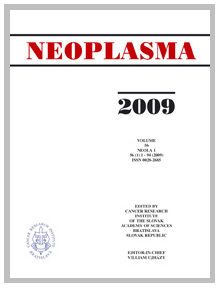Journal info
|
||
Select Journal
Journals
Bratislava Medical Journal Ekologia - Ecology Endocrine Regulations General Physiology and Biophysics Neoplasma 2025 Ahead of print 2024 2023 2022 2021 2020 2019 2018 2016 2017 2015 2014 2013 2012 2011 2010 2009 2008 2007 2006 2005 2004 2003 Acta Virologica Studia Psychologica Cardiology Letters Psychológia a patopsych. dieťaťa Kovove Materialy-Metallic Materials Slovenská hudba 2025Webshop Cart
Your Cart is currently empty.
Info: Your browser does not accept cookies. To put products into your cart and purchase them you need to enable cookies.
Neoplasma Vol.61, No.6, p.700-709, 2014 |
||
| Title: Realgar (As4S4) nanoparticles and arsenic trioxide (As2O3) induced autophagy and apoptosis in human melanoma cells in vitro | ||
| Author: M. PASTOREK, P. GRONESOVA, D. CHOLUJOVA, L. HUNAKOVA, Z. BUJNAKOVA, P. BALAZ, J. DURAJ, T. C. LEE, J. SEDLAK | ||
| Abstract: The aim of the present study was to compare the effect of realgar nanoparticles and arsenic trioxide (ATO) on viability, DNA damage, proliferation, autophagy and apoptosis in the human melanoma cell lines BOWES and A375. The application of various flow cytometric methods for measurements cell viability, DNA cell cycle, mitochondrial potential, lysosomal activity, and intracellular content of glutathione was used. In addition, quantitative PCR, western blotting and multiplex bead array analyses were applied for evaluation of redox stress, autophagic flux, and cell signaling alterations. The results showed that realgar treatment of studied cells caused modulation of cell proliferation, induced a block in G2/M phase of the cell cycle and altered phosphorylation of IκB, Akt, ERK1/2, p38, and JNK kinases, as well as decreased mitochondrial membrane potential. Additionally, it appeared that induction of cell death by both realgar and ATO was dose-dependent, when lower (0.3 µM) dosage increased lysosomal activity and induced autophagy and higher (1.25 µM) concentration resulted in the appearance of apoptosis, while pan-caspase inhibitor attenuated more efficiently realgar- than ATO-induced cell death. Furthermore, low concentrations of ATO and realgar nanoparticles increased the content of intracellular glutathione and elevated γ-H2AX expression confirmed DNA damage preferentially at higher concentrations of both drugs used. Further analysis revealed slight differences in time-dependent phosphorylation pattern due to both realgar and ATO treatments, while significant differences were noticed between cell lines. In conclusion, realgar nanoparticles and ATO treatment induced dose-dependent activation of autophagy and apoptosis in both melanoma cell lines, when autophagy flux was determined at lower drug concentrations and the switch to apoptosis occurred at higher concentrations of both arsenic forms. |
||
| Keywords: realgar, autophagy, cell cycle, DNA damage, Nrf2, chloroquine, Z-VAD-FMK, glutathione | ||
| Published online: 23-Aug-2014 | ||
| Year: 2014, Volume: 61, Issue: 6 | Page From: 700, Page To: 709 | |
| doi:10.4149/neo_2014_085 |
||
|
|
 download file download file |
|

